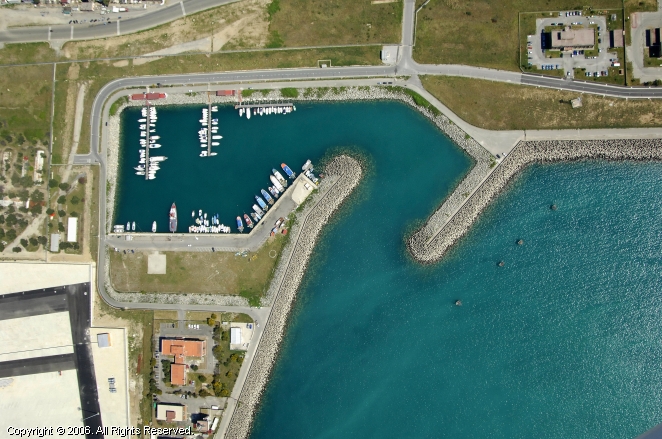The port of Gioia Tauro is the busiest and largest container terminal in Italy and the Mediterranean Sea. The Gioia Tauro Port Authority is responsible for managing and operating the port.
Gioia Tauro Harbour contains 5.2 meters of quays with alongside depths up to 18 meters. The Gioia Tauro Harbour covers about 440 hectares of land area and contains 1.8 million square meters of stocking yards. It is connected by road and rail with inland Italy.
In the 1970s, Gioia Tauro Harbour was initially supposed to serve the iron and steel industry. Declines in the industry, however, led to abandonment of those plans, and Gioia Tauro Harbour was a “ghost port” from 1973 until the 1990s. In 1994, the Contship Group undertook an effort to convert the port to a container terminal. The first container vessel anchored at the Medcenter Container Terminal in 1995.
Located in the Reggio Calabria Province at the tip of the Italian “boot,” Gioia Tauro Harbour is the seventh biggest container port in Europe, handling 3.7 million TEUs of containerized cargo on over three thousand vessels in 2007. The port handles over one-third of Italy’s national traffic, and it specializes in trade with the USA and the Far East.
On the busy route between the Suez Canal and Gibraltar, Gioia Tauro Harbour is on one of the world’s busiest maritime corridors. Traffic increased from 50 ships and 17 thousand TEUs in 1995 to over three thousand ships and 2.6 million TEUs in 2003. Gioia Tauro Harbour has added over a thousand jobs for the local economy.
The Gioia Tauro Terminal contains quays of 280 and 436 meters and surface area of 270 hectares. The terminal offers three deep-water and two short-sea berths with alongside depths from 13.5 to 15.5 meters. The terminal includes three state-of-the-art Vehicle Processing Centers spread over the terminals to handle cars before delivery to the end customer. The Terminal’s regular roll-on/roll-off service handles new and used cars.
Continuing investments will assure the position of Gioia Tauro Harbour into the future. Plans include enlarging the basin and harbor entrance, dredging to 18 meters, lengthening the wharves, and providing facilities for manufacturers and logistics firms with refrigerated goods.
In 2006, Italian investigators suggested that as much as 80% of Europe’s cocaine traffic from Colombia passes through Gioia Tauro Harbour. The port is also thought to be involved in the trade of illegal arms. In fact, Gioia Tauro’s city council was dissolved in 1991 and again in 2008 because it had been infiltrated by the “Ndrangheta,” one of Italy’s most powerful crime syndicates.
According to a 2006 report, Italian investigators estimate that 80% of Europe's cocaine arrives from Colombia via Gioia Tauro's docks. The port is also involved
in the illegal arms trade. These activities are controlled by the 'Ndrangheta. However, according to a report of the European Monitoring Centre for Drugs and Drug Addiction (EMCDDA) and Europol, the Iberian Peninsula is considered the main entry point for cocaine into Europe and a gateway to the European market.
The Piromalli-Molè clan managed to condition the management of the new container terminal. Established in the mid-1990s, it became the largest terminal in the Mediterranean, moving over 2 million containers in 1998. Since 1994, when Contship Italia rented the port area to start transshipment activity and the Medcenter Container Terminal was set up thanks to 138 billion lire (about US$86 million) in state financing, the Piromalli’s aimed to oblige the Medcenter company, through its vice president Walter Lugli, and the Contship company, through its president Enrico Ravano, to pay a kickback of US$1.50 for each transshipped container, a sum which corresponded to about half the net profits earned by the two companies.
In February 2008 the parliamentary Antimafia Commission concluded that the ‘Ndrangheta “controls or influences a large part of the economic activity around the port and uses the facility as a base for illegal trafficking.” In its report it said that “the entire gamma of internal or sub-contracted activities is mafia-influenced, from the management of distribution and forwarding to customs control and container storage.” The extortion of Ravano and Contship, was part of a project that “did not involve simply this security tax, which grew with the port, but also control of activities tied to the port, the hiring of workers, and relations with port unions and local institutions,” the report added. “It effectively eliminated legitimate competition from companies not influenced or controlled by the mafia in providing goods and services, performing construction work and hiring personnel. And it threw a shadow over the behaviour of local government and other public bodies.



Ask them about the techniques they employ in bringing about results and when to expect a positive outcome.
ReplyDeleteApart from the enhancements done on the portal pages, it is important to involve directory submissions and link building
as part of the web promotion activities. These businesses totally rely on the
search engine traffics.
Also visit my web site; รับทำ seo ราคาถูก